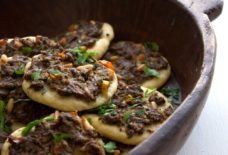Mediterranean Cooking from the Garden with Linda Dalal Sawaya: 5 easy ways to use your homegrown Italian fresh parsley right now—Lebanese style!
As an artist, cook, and gardener, for me the Pacific Northwest is nirvana for cooking seasonal Mediterranean cuisine, painting en plein air, and for planting almost anything.
Right now in my garden the flat leaved Italian parsley, Petroselinum crispum neapolitanum, the straight alternate to curly parsley Petroselinum crispum, has thrived over our mild Mediterranean-like winter as a biennial, and is shooting skyward to flower and set seed.
This is a perfect time to harvest it for one of these Lebanese/Mediterranean salads or divine accompaniments on your springtime table—vegan or otherwise. Italian parsley is more flavorful than the curly variety and is recommended for these recipes. In addition to how wonderful this herb tastes, it is an excellent source of iron, vitamin A, flavonoids, antioxidants, even protein, and more.
If you decide to let it flower and seed, it attracts butterflies, bees, and other nectar-loving insects. Native to the Mediterranean, and as named Neopolitanum—from Naples, it is naturally grown throughout the region, including Lebanon. Yet I am craving greens, so I’m out there with my scissors! And if you don’t have a kitchen garden to cut from, find some organic Italian parsley at your favorite shop or local farmer’s market.
italian parsley (photo © linda dalal sawaya)
Lebanese tabbouli with quinoa (photo © linda dalal sawaya)1. Tabbouli
Spearmint is right there with Italian parsley in the garden waiting to be picked for the most refreshing salad in the world. Use quinoa either sprouted or cooked and cooled to make a gluten free tabbouli instead of the traditional bulgar. Last fall on my trip to Lebanon, my friend Bashar told me about a great “fast food” yet fantastic Lebanese restaurant called Kababji in Beirut that serves tabbouli with quinoa on their “light” menu. Traditional Lebanese tabbouli has parsley as the star ingredient, followed by spearmint, green onions, bulgar (or quinoa as a gluten-free alternate), chopped fresh tomatoes (or organic diced canned tomatoes), fresh squeezed lemon juice, olive oil, salt, and cayenne pepper. My mother, Alice, served it in romaine lettuce “boats” that we devoured like tacos.
Lebanese potato salad (photo © linda dalal sawaya)
2. Lebanese potato salad
Unlike creamy, and yes, fattening, Western types of potato salad, our vegan Lebanese potato salad is lightly drizzled with a garlic, olive oil, and lemon juice dressing. With spring green onions, also overwintered in the garden, fresh parsley and spearmint, this irresistible spring recipe is easy-to-make and can be enjoyed warm, at room temperature, or cold.
3. Fattoush
Although tabbouli ranks as my favorite lebanese salad and is so popular and super nutritious, fattoush is a close second. This Arabic word comes from the word fatte meaning broken up or pieces, which refers to the broken pieces of Arabic or pita bread that are crisped and added to the salad just before tossing. It’s easier to make than tabbouli, which i often crave at this spring time of year, when the parsley and mint in my garden are thriving in Oregon’s welcome rain. Both salads include these two herbs along with green onions and a dressing of fresh squeezed lemons and olive oil, salt and pepper. No garlic! Recipes for both are in Alice’s Kitchen: Traditional Lebanese Cooking. The ingredients for fattoush are: romaine lettuce, cucumbers, green onion, parsley, spearmint, sumac (optional), and purslane (when it’s available in the summer garden…it just shows up as a weed!
Lebanese omelette (ijhee) ingredients (photo © linda dalal sawaya)
Lebanese omelette (ijhee) ingredients before adding eggs (photo © linda dalal sawaya)
(Lebanese omelette (ijhee) mini appetizers (photo © linda dalal sawaya)
4. Lebanese omelette—Ijhee
This is the time of year when the parsley and mint are coming back to life in the Pacific Northwest, having gone dormant for a brief time of winter. i love exploring the garden to find these essential ingredients for our fabulous Lebanese omelette that is perhaps more of a frittata than an omelette. it is very green, indeed, and full of nutrients with unique spicing of cinnamon and cayenne pepper and is very light on the eggs. The recipe for ijhee is simple and easy-to-make. Ingredients: fresh eggs, onions—both green and spanish, Italian parsley, spearmint, flour, cinnamon, cayenne pepper, baking powder, and salt. Sautéed in clarified butter, served in pita pocket bread with cured olives, feta cheese, and fresh cucumbers, the omelette is made in individual mini pita sizes for appetizers or cooked in a big cast iron skillet and cut into pie shapes to tuck into a pocket.
Lebanese cole slaw (photo © linda dalal sawaya)
5. Cabbage salad or Lebanese coleslaw
What comes to mind when someone says “coleslaw”? Something usually creamy, soggy, and limp, right? Not this bright green Lebanese version, which is refreshing, light, super easy to make, and nutritious, too. Shredded cabbage—savoy or not—with chopped spring green onions, Italian parsley, spearmint, drizzled with garlic, lemon, and olive oil dressing makes a crisp and tangy alternative for your dining table.
Linda Dalal Sawaya
Special to Arab America
( Linda Dalal Sawaya, daughter of two Lebanese immigrants, is a Portland, Oregon artist, cook, and author of Alice’s Kitchen: Traditional Lebanese Cooking — all text and photos © linda dalal sawaya 2015).



